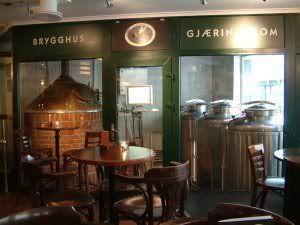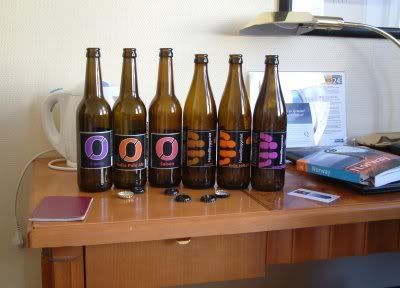 "Forty-five bucks!? This better be the best tasting beer in the world. [Drinks] You got lucky." -- Barney Gumble
"Forty-five bucks!? This better be the best tasting beer in the world. [Drinks] You got lucky." -- Barney Gumble
Let's face it: Oslo is not the obvious choice for a beer-hunting weekend. Two contributing factors spring immediately to mind: the state monopoly on selling booze, and the ferocious price of the stuff. Armed with these prejudices I marched into Norway prepared to do battle with inaccessible over-priced mediocrity. I was surprised by what I found, though not about the price bit...
First of all, it's not strictly true that the state has a monopoly on selling alcohol. The only off-licences are indeed the state-run Vinmonopolet chain, and they close by 6 on weekdays, 3 on Saturdays and all day Sunday. Fortunately, however, Vinmonopolet's jurisdiction only covers drinks over 4.7% alcohol. Weaker beers, mostly at the 4.5% mark, are sold in supermarkets, which keep something akin to regular hours.
Bar and restaurant hours are pretty much the same as any other European city, and most places will have a lager from a local brewery on tap. If you're lucky you might find another tap and perhaps a modest selection of bottles, local and imported.
There appear to be very tight restrictions on advertising alcohol in Norway -- no TV ads, no posters, no sponsorship, not even pubsigns or beermats from what I saw -- so it's hard to judge who dominates the market. The common local brands are Ringnes, Hansa, Borg and Aass, all of whom sell a dizzying array of products. As well as a standard pilsener, they all make a low-alcohol version (lettøl), a draught-style version (fatøl), a strong version (gull), a dark version (bayer) and a bock (bokkøl). In season, I'm reliably informed, they all have a Christmas beer (juløl), but since I was visiting in August, the range of summer beers (sommerøl) filled the supermarket shelves. Quality-wise they're much of a muchness. The bocks were generally quite pleasant, speaking as a bock sceptic -- not too sugary with some good caramel and liquorice notes, especially the Borg Bokkøl. Prices start at about €2.50* for a 500ml can of weak lager in a supermarket. For a 330ml bottle of bock in Vinmonopolet, you're heading towards a fiver. A 400ml glass of plain pils in a bar or restaurant will generally cost something between €7 and €9, depending on where you are.
(*Currency conversions are based on the particularly usurous rate I got from my credit card provider. The evilness of your bank may vary.)
So far, so ordinary. Fortunately, Norway is blessed with two top-quality craft breweries: HaandBryggeriet and Nøgne Ø (literally "Naked Island"). Both produce distinctive half-litre bottles and the range is staggering. On the shelves of Vinmonopolet, and the better class of supermarket (depending on the strength), you will find porters, stouts, wits, weisses, IPAs, English-style bitter, maibocks, and much more besides. I don't think I even scratched the surface of their current outputs, but I did find their dark beers particularly excellent. Take-away prices for the low-strength beers start at about €4.50 a bottle; moving up to the Vinmonopolet category, €8-€9 is normal.
I didn't really hit the bar scene in a major way. Drinking at home before going out is the norm in Norway, and my research was definitely better served by Oslo's bottle shops than its bars. So for the most part, I confined myself to drinking in my hotel room. A couple of bars are worthy of note, however. Like many cities, Oslo has redeveloped its decayed wharfs into a complex of shops, bars and restaurants. This area, called Aker Brygge, includes the Lekter'n bar (Stranden 3) right down on the waterfront. The openair lounge is furnished with beanbags, so you can recline with superb views of the Oslofjord and the fortress. Since you're paying €8.50 for that bland lager, you may as well enjoy it in style.
going out is the norm in Norway, and my research was definitely better served by Oslo's bottle shops than its bars. So for the most part, I confined myself to drinking in my hotel room. A couple of bars are worthy of note, however. Like many cities, Oslo has redeveloped its decayed wharfs into a complex of shops, bars and restaurants. This area, called Aker Brygge, includes the Lekter'n bar (Stranden 3) right down on the waterfront. The openair lounge is furnished with beanbags, so you can recline with superb views of the Oslofjord and the fortress. Since you're paying €8.50 for that bland lager, you may as well enjoy it in style.
Three Oslo bars are especially well-known for their beer selection. Foremost is Lorry (Parkveien 12), about 15 minutes' walk from the centre of town, which claims to stock over 130 beers from 27 countries. Inside, the décor is reminiscent of the golden age of steam locomotion, all leather-upholstery and brass rails. There's a large outside terrace too. The beerlist was a let-down: lots there, but very little you wouldn't expect to find in a half-way decent off licence at home. Unless you fancy paying a tenner for a bottle of Old Speckled Hen, there's not much of interest. Only one craft beer, a pilsener from HaandBryggeriet, featured in the Norwegian section.
I had a recommendation to try a bar called Kampens Hete (Hagegata 39), near the Munch museum, a couple of metro stops out from the centre. Their menu lists 33 beers, including four by Nøgne Ø, at quite a reasonable mark-up. Unfortunately, the place had closed for the month of August so I never got further than the front door. It looked nice, though. Um.
Back in the centre of town, the back of the Aker Brygge area is home to the Beer Palace (Holmens gate 3), housed in a beautiful redbrick building, with a cosy downstairs vault and an airy first-floor terrace. I counted 64 beers available, but just two craft offerings, both from HaandBryggeriet. And how much to enjoy a half-litre of finest Norwegian craft beer in such salubrious surrounds? To you a mere €12.70. Yes: twelve seventy. I ordered the Ardenne Blond which, it turns out, is an extremely fizzy beer. Due, no doubt, to an oversight in the barmaid's extensive training, she did not appear to be aware of this, so when she popped the cap the beer exploded and it was quite gratifying to watch about €6-worth of beer spill all over the bar. She gave me the replacement bottle with the cap still on. I took it out to the terrace and opened it very very carefully.
3), housed in a beautiful redbrick building, with a cosy downstairs vault and an airy first-floor terrace. I counted 64 beers available, but just two craft offerings, both from HaandBryggeriet. And how much to enjoy a half-litre of finest Norwegian craft beer in such salubrious surrounds? To you a mere €12.70. Yes: twelve seventy. I ordered the Ardenne Blond which, it turns out, is an extremely fizzy beer. Due, no doubt, to an oversight in the barmaid's extensive training, she did not appear to be aware of this, so when she popped the cap the beer exploded and it was quite gratifying to watch about €6-worth of beer spill all over the bar. She gave me the replacement bottle with the cap still on. I took it out to the terrace and opened it very very carefully.
There is one brewpub in Oslo, about another ten minutes past Lorry as you leave the centre, and well worth the extra walk. The Oslo Mikrobryggeri (Bogstadveien 6, entrance on Holtegata) has been going since 1989, and seems to have used the time well. A total of eight beers are on regular rotation, five were on tap on my visit, and I tried four (skipping the pils. You all know what pils tastes like by now, I hope.) Steamer is the house speciality, a refreshing bittersweet dark red ale. Their stout is first rate, though their IPA isn't so great, being nitro-kegged and a bit thin. I recommend Amber X in its place: a light and zesty American-style pale ale.
worth the extra walk. The Oslo Mikrobryggeri (Bogstadveien 6, entrance on Holtegata) has been going since 1989, and seems to have used the time well. A total of eight beers are on regular rotation, five were on tap on my visit, and I tried four (skipping the pils. You all know what pils tastes like by now, I hope.) Steamer is the house speciality, a refreshing bittersweet dark red ale. Their stout is first rate, though their IPA isn't so great, being nitro-kegged and a bit thin. I recommend Amber X in its place: a light and zesty American-style pale ale.
Outside of Oslo, there's another brewpub in the sleepy logging town of Moss, 40 minutes south of Oslo by train. Across town from the station, an old industrial complex is being rejuvenated, and the Møllebyen Mikrobryggeri (Fossen 21) occupies a magnificent former factory building. Inside it's all red brick and wood beams with a lounge area, casual tables and a more formal dining area. The food is definitely a cut above the average pub fodder. They make two lagers, a dunkelweiss, a mild English-style ale and a porter, mostly pretty decent. As usual, the darker beers are better. Best of all, they're sold at bargain-basement prices of about €7. However, barstool calculations show you need to drink 28 pints to recoup the cost of your train fare out of more-expensive Oslo.
If you're wondering what to do with your rollover jackpot win, or urgently need to dispose of that briefcase of drug money the dead guy left under the bed in your spare room, and if you've had as much Sam Adams Utopias as you can take, then you could do a lot worse than a weekend's beering in Oslo.

